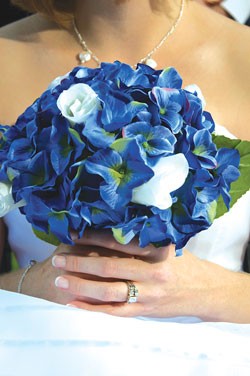
What’s the deal with that old wedding superstition “Something old, something new…”?
Rarely have I attended a wedding and not shaken my head in bewilderment at the many odd customs that seem de rigueur at nuptials. There’s the rice throwing and the bouquet tossing, the wedding cake feeding and the creepy garter-belt business. On top of that, you have the stiff wedding march, the nervous first dance, the often ugly bridesmaids’ dresses and even the rings themselves.
Before the wedding, there’s the whole uncomfortable bridal shower mess, with its attendant tears and bizarre paper-plate bouquets. And after the wedding, there’s the honeymoon — so named ages ago for the interval during which husbands got to dip into the honeypot before the wife closed it up again.
Many of you have probably found yourselves in a church, a barn or a fire hall (that’s where my people get hitched) wondering what is taking place in front of you, besides two people agreeing never to have sex with other people again. Lucky for you, Seven Days is here with answers. Well, one answer, anyway: the origin of “Something old, something new, something borrowed, something blue.”
According to etiquette maven Emily Post’s successor, Peggy Post, “It is the duty of the maid of honor and the bridesmaids to check that the bride is wearing something old, something new, something borrowed, something blue.” No exceptions to this most common of wedding rituals.
Just about every bride I’ve ever known, even those who are saucy and cynical and never thought they’d even get married, has succumbed to this superstition. How could they not? They didn’t want to risk a lifetime of marital drudgery and regret over what a heinous disaster their marriage had become if they didn’t fulfill the verse.
So, to prevent such misfortune and ensure a successful union, many brides carry something old, something new, something borrowed and something blue somewhere on their person as they sashay down the aisle. If it were me, I would borrow your grandmother for the day and call her my own. She’s old as hell, but she’s new to me. And she has blue hair. Perfect. But most brides tend to go with things such as hankies or bouquets studded with delphiniums. Some brides fulfill all the stipulations in one item, while others collect one of each.
But there’s one more step the ladies in white are missing. The original English verse, which wedding book author Ann Monsarrat says is thought to date back to the early 19th century, goes like this:
Something old, something new
Something borrowed, something blue
And silver sixpence in your shoe.
Let me break it down for you:
Something old: This represents continuity and gives a nod to family ties and annoying in-laws.
Something new: This represents the life the couple will forge together, barfing babies, housing foreclosures and all.
Something borrowed: This represents the idea of a friend’s or family member’s good fortune carrying over to the bride. (Caveat: You can’t borrow something from just anyone; the item has to come from a happily married woman. If you can find one.)
Something blue: This represents faithfulness, purity and loyalty. Yes, all of them. Back when women were chattel and selected for marriage based on the size of their trousseaux, the color blue symbolized fidelity.
This part of the superstition most likely derives from the adage “Married in blue, love ever true,” writes Michael Olmert in his book Milton’s Teeth and Ovid’s Umbrella: Curiouser and Curiouser Adventures in History. Before white wedding dresses became en vogue thanks to Queen Victoria, brides wore blue. Not coincidentally, so did the Virgin Mary. So, by wearing something blue — perhaps in the form of a classy, periwinkle-hued garter belt — the bride lets people know that she’s untouched by the filthy mitts of other men. And she’s in this match for life, kind of like being in a gang.
Silver sixpence: This part of the verse is the bridal equivalent of throwing a penny into a fountain. While most women don’t put sixpence in their shoes anymore — mostly because the coins were demonetized in 1971 — they should. A sweaty sixpence in the shoe is an attempt to assuage Diana, Roman patroness of unmarried girls and chastity. See, Diana doesn’t much care for virgins being taken off the market. Thus, if brides do not want to incur her wrath, they’ll offer a little bribe of silver, the metal associated with the huntress. If you want extra good luck, put the sixpence in your left shoe.
While the author of the verse is unknown, it must be acknowledged that he or she was damned persuasive. Two centuries after it was penned, the rhyme remains gospel for brides, superstitious or not. And since nearly half of marriages end in divorce, it’s a naive bride who thinks she doesn’t need an extra bit of luck for the future.
Outraged, or merely curious, about something? Send your burning question to [email protected].









Comments
Comments are closed.
From 2014-2020, Seven Days allowed readers to comment on all stories posted on our website. While we've appreciated the suggestions and insights, right now Seven Days is prioritizing our core mission — producing high-quality, responsible local journalism — over moderating online debates between readers.
To criticize, correct or praise our reporting, please send us a letter to the editor or send us a tip. We’ll check it out and report the results.
Online comments may return when we have better tech tools for managing them. Thanks for reading.